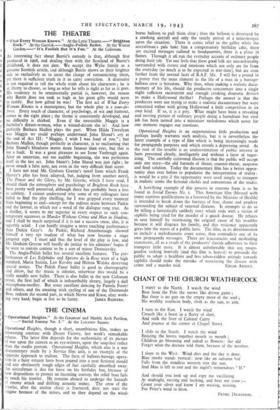THE CINEMA
" Operational Heights." At the Gaumont and Marble Arch Pavilion. --" Social Enemy No. I." At the Leicester Square.
Operational Heights, though a short, unambitious film, makes an interesting contrast with Desert Victory, last week's remarkable release. The latter film depends for the authenticity of its picture of war upon the camera as an eye-witness, upon the snapshot rather than the studio portrait. Operational Heights, which also is a war documentary made by a Service film unit, is an example of the opposite approach to realism. The facts of balloon-barrage opera- tion in a busy estuary have been poured into a neat fictional mould and any obstinately rough edges of fact carefully smoothed away. An aircraftman is due for leave on his birthday but, because of new dispositions to protect an incoming convoy, the relief boat fails to reach his trawler. He remains aboard to undergo the hazards of enemy attack and drifting acoustic mines. The crew of the trawler, after the anchor chain is fractured, dare not start the engine because of the mines, and so they depend on the wind- borne balloon to pull them clear ; then the balloon is destroyed by a crashing aircraft and only the timely arrival of a minesweeper saves the situation. There is comic relief in the galley while the aircrafttnaUs pals bake him a compensatory birthday cake, there are excited messages radioed to headquarters, there is a plane in flames. Through it all run the everyday accents of ordinary people doing their job. Yet one feels that these good folk are uncomfortably surrounded with events and emotions which not only arc far from the everyday (so much is to be expected in war-time), but are even farther from the normal facts of R.A.F. life. I will bet a pound to a penny that the main clement in the life of a man in a barrage- balloon crew is boredom. Why then, when making a realistic docu- mentary of his life, should the producers concentrate into a single night sufficient excitement and enough creaking dramatic devices to make a Hollywood thriller? Perhaps the answer is that the producers were not trying to make a realistic documentary but were concerned rather with giving Hollywood a little competition in its own kind. If so, it is a pity. What might have been a revealing and moving picture of ordinary people doing a humdrum but vital job has been turned into a miniature melodrama which never for one moment engages our emotions, Operational Heights is an unpretentious little production and perhaps hardly warrants such analysis, but it is nevertheless the latest example of a type of film which is being increasingly made for propaganda purposes and which reveals a depressing trend. At the root of the trouble is an underestimation of public interest in facts presented clearly, intelligently and without a layer of sugar- icing. The carefully cultivated illusion is that the public will accept only one story—the old formula of threat, counter-threat, suspense and final solution. Today the documentary film has a better oppor- tunity than ever before to popularise the interpretation of reality: it would be a pity if the opportunity were used simply to interpret in realistic terms the fictional clichés and conventions of the studio.
A horrifying example of this process in extreme form is to be found in Social Enemy No. t. This American film (blessed with many cautious qualifications in a foreword by the Minister of Health) is intended to break down the barriers of fear, shame and prudery surrounding the subject of venereal diseases. It attempts to do so by telling a fantastically unlikely story which ends with a victim of syphilis being tried for the murder of a quack doctor. He refuses to save himself by mentioning the original cause of his troubles because it will disgrace his family, and this reticence apparently gives him the status of a public hero. The film, in its determination to include a melodramatic court scene, thus contradicts one of its own propaganda messages. There are ir.accuracies and misleading statements, all as a result of the producers' slavish adherence to their trumpery little story. It is almost unbelievable that any propa- gandist seeking honestly (and this film is honest) to persuade the public to adopt a healthier and less taboo-ridden attitude towards syphilis should make the mistake of associating the disease with


























 Previous page
Previous page